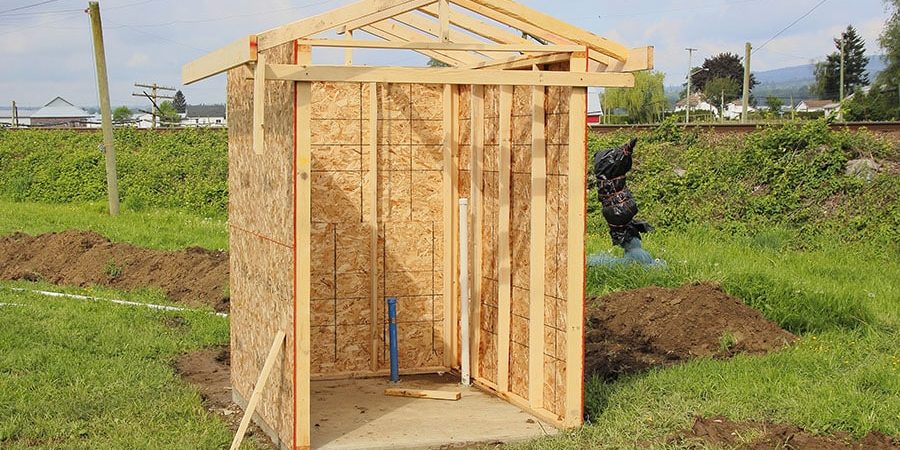Sometimes, it feels like property can fall apart overnight.
If you’ve ever walked into your backyard and noticed that your go-to storage shed is leaning, you may have wondered how this could have happened and how you can fix a leaning shed for good.
In most cases, the solution is simpler than you think.
With just 3 easy steps, you can set your shed back upright and build a firm foundation that stands the test of time, so you never have to worry about costly shed maintenance again.
How to Fix a Leaning Shed?
Before you can start fixing your shed, you’ll need to evaluate the foundation it’s sitting on, whether you build it yourself or it came with your home.
Step 1: Find the Cause of the Lean
Typically, there are 3 main causes of a leaning shed that will require a different approach for repair. Once you’ve determined the source of your problem, you can start to reset the damage at the root.
Soil Erosion
If your shed is sitting on dirt or a gravel foundation, then chances are soil erosion will eventually disrupt its balance.
As rain, wind, and other elements push the soil away from the shed’s base and into the surrounding areas in your hard, your shed will gradually begin to shift in one direction, creating the “leaning” appearance.
You can tell if erosion is to blame for your leaning shed by checking the ground underneath your foundation for uneven dips or bumps.
Shifting Slope
No matter how level your foundation may have started, most natural materials will gradually shift as time goes on, creating a sloping effect that disrupts your shed.
Most of the time, this occurs when there isn’t a suitable slope-protection feature in your shed’s foundation, which would counteract this concern.
You can determine if a slope is causing your shed to lean by examining the surroundings in your hard for inconsistent hills or bumps.
Structural Damage
Unfortunately, damage to your shed’s materials or structure is more complex and costly to repair.
Many elements can cause the wood of your shed to become weak, leading to a noticeable lean. Some of the most common causes of this include termites, wood rot, and wind damage from poor weather.
You can tell if your shed’s structure is compromised by searching for tell-tale signs of pests or rotting wood.
Step 2: Upgrade Your Foundation
Next, you’ll need to start repairing your shed from the ground up.
If soil erosion or sloping is to blame for your shed’s lean, then you’ll likely want to upgrade to a more durable foundation system that will withstand the elements.
Unlike traditional dirt and gravel foundations, a modern geocell base can give your shed long-term durability at an affordable price. This honeycomb-shaped, three-dimensional system is made from premium high-density polythene (HDPE) and can be used with a variety of infill materials to meet your needs.
BackyardBases geocell as the Best Solution for a Leaning Shed
Here’s what makes geocell the best solution for leaning shed…
Dirt or Gravel Foundations:
- Erode and shift over time
- Poor water drainage, leading to potential wood rot
- Frequently need to be replenished or repaired
- Light load support for sheds with heavy equipment
Vs.
Geocell Foundations:
- Stay firmly in place over time
- Built-in water drainage to prevent erosion and rotting
- Designed to last for up to 75 years without repair
- Maximum load support for heavy materials
- Easy and affordable to install
Bottom line?
If you’re tired of constantly worrying about the stability of your shed, a geocell foundation can give you the support you need for years to come.
Step 3: Reset Your Shed
Once you’ve picked the right foundation and infill for your project, you can reset your shed and prevent future leaning.
To do this, you’ll need to restabilize the surface area by digging out and removing excess dirt and gravel, either by moving your shed completely or using concrete slabs to elevate it off the ground.
This gives you the ability to put a new shed foundation in place one section at a time, ensuring that your final space is completely level and free from slopes or dips.
And if you’re using a geocell base, you’ll automatically be including a perforated water drainage system that naturally removes moisture from your shed’s foundation without any additional materials.
Finally, you can safely secure your shed by placing it firmly back on the ground after your base has fully settled into place, with no more leaning or tilting.
Ready to Set Your Shed Straight?
We know that tackling D.I.Y projects can be stressful.
That’s why Backyard Bases is committed to providing industry-leading geocell technology at an affordable price, delivered directly to your doorstep in one easy-to-use kit.
Our shed foundation systems are simple to install, low-maintenance and built to last for decades, so you can get the most out of your project.
Shop our full range of geocell foundations today.
